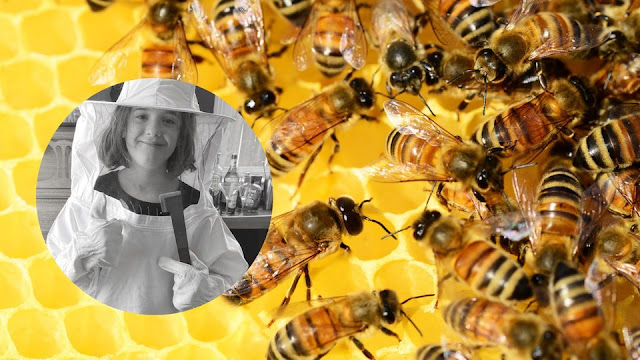

|
| Beekeeper Clara will present her bee marathon on Facebook this weekend. (Photo courtesy Clara) |
One enterprising Girl Scout Junior is doing her part to help bees, and she’s inviting other kids – and grown-ups, too – to improve their bee IQ.
“Bee the Change with Beekeeper Clara” is a two-day online marathon, hosted by a youthful backyard beekeeper. Set for 9 a.m. Saturday, July 9 , to 9 p.m. Sunday, July 10 , the virtual event is free and open to anyone with Facebook access.
Karysa LeAnn, Clara’s mom, shared the event to the Sacramento Garden Group on Facebook. Karysa also is monitoring and managing the event to make sure it’s safe (both around the bees and the Internet). But Clara is leading the project and the content.
According to Clara’s webpage, it will be a “weekend of total brain pollination – instead of pollen, we're transferring knowledge! Learn about different types of bees, a little about what backyard beekeeping looks like for our family, and how you can ‘bee’ a friend to these fuzzy pollinators. We'll have live broadcast presentations, interactive live Q&A sessions, informative pictures and posts, and instructions for easy DIY projects.”
The projects and information will be “great for kids and grown-ups alike,” says Clara. “Times for live broadcasts to be announced; replays will be available if you're ‘buzzzy’.”
This project combines Clara’s love of bees and scouting. Clara is a Girl Scout Junior and backyard honey beekeeper, “who loves to create a buzz about the things she cares about,” says her mom. “This educational event is the final step in her path towards earning her Bronze Award, the highest honor a Junior level Girl Scout can receive.”
Girl Scout Juniors are girls in grades 4 and 5.
“You may want to keep notetaking supplies handy,” suggests Clara. “DIY projects can usually be completed with household objects and items found easily in most yards.”
Clara’s bee-class idea is catching. As of
Tuesday morning
, 32 people are “definitely attending,” with another 144 interested.
Comments
0 comments have been posted.Sacramento Digs Gardening to your inbox.
Food in My Back Yard Series
April 22: Should you stock up on fertilizer? (Yes!)
April 15: Grow culinary herbs in containers
April 8: When to plant summer vegetables
April 1: Don't be fooled by these garden myths
March 25: Fertilizer tips: How to 'feed' your vegetables for healthy growth
March 18: Time to give vegetable seedlings some more space
March 11: Ways to win the fight against weeds
March 4: Potatoes from the garden
Feb. 25: Plant a fruit tree now -- for later
Feb. 18: How to squeeze more food into less space
Feb. 11: When to plant? Consider staggering your transplants
Feb. 4: Starting in seed starting
Sites We Like
Garden Checklist for week of April 27
Once the clouds clear, get to work. Spring growth is in high gear.
* Set out tomato, pepper and eggplant transplants.
* From seed, plant beans, beets, cantaloupes, carrots, corn, cucumbers, melons, pumpkins, radishes and squash. Plant onion sets.
* In the flower garden, plant seeds for asters, cosmos, celosia, marigolds, salvia, sunflowers and zinnias. Transplant petunias, zinnias, geraniums and other summer bloomers.
* Plant perennials and dahlia tubers for summer bloom. Late April is about the last chance to plant summer bulbs, such as gladiolus and tuberous begonias.
* Transplant lettuce and cabbage seedlings.
* Weed, weed, weed! Don’t let unwanted plants go to seed.
* April is the last chance to plant citrus trees such as dwarf orange, lemon and kumquat. These trees also look good in landscaping and provide fresh fruit in winter.
* Feed citrus trees with a low dose of balanced fertilizer (such as 10-10-10) during bloom to help set fruit. Keep an eye out for ants.
* Apply slow-release fertilizer to the lawn.
* Thoroughly clean debris from the bottom of outdoor ponds or fountains.
* Start thinning fruit that's formed on apple and stone fruit trees -- you'll get larger fruit at harvest (and avoid limb breakage) if some is thinned now. The UC recommendation is to thin fruit when it is about 3/4 of an inch in diameter. Peaches and nectarines should be thinned to about 6 inches apart; smaller fruit such as plums and pluots can be about 4 inches apart. Apricots can be left at 3 inches apart. Apples and pears should be thinned to one fruit per cluster of flowers, 6 to 8 inches apart.
* Azaleas and camellias looking a little yellow? If leaves are turning yellow between the veins, give them a boost with chelated iron.
* Trim dead flowers but not leaves from spring-flowering bulbs such as daffodils and tulips. Those leaves gather energy to create next year's flowers. Also, give the bulbs a fertilizer boost after bloom.
* Pinch chrysanthemums back to 12 inches for fall flowers. Cut old stems to the ground.
* Mulch around plants to conserve moisture and control weeds.